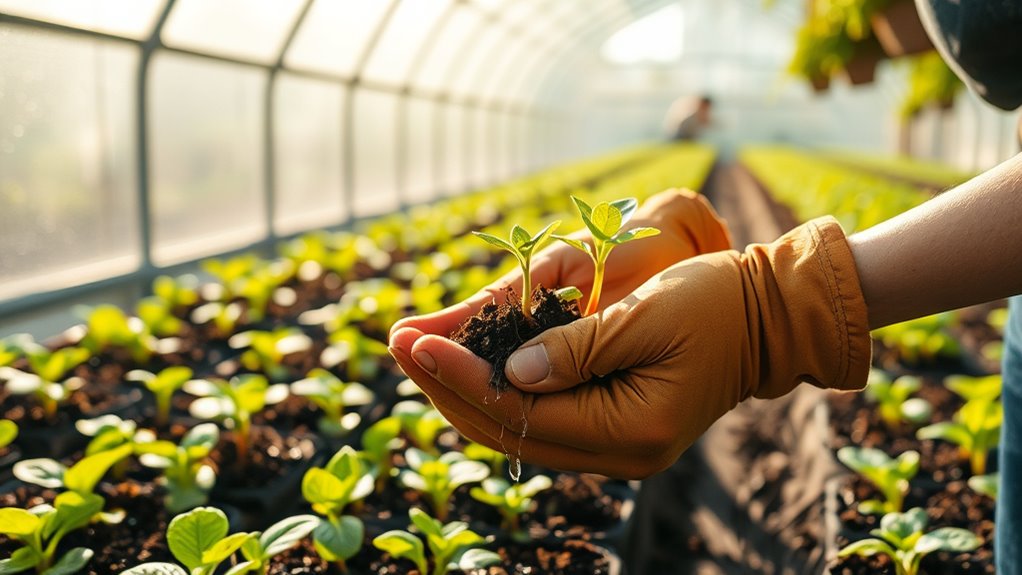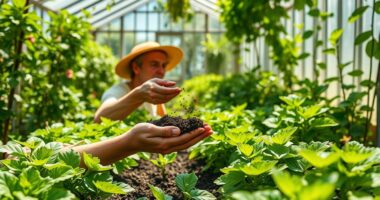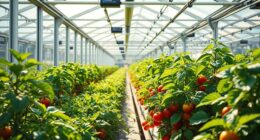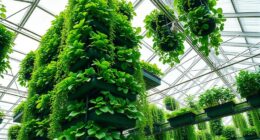Transplanting seedlings into your greenhouse requires the right timing and preparation. Wait until your seedlings have 2-3 true leaves and temperatures are suitable—above freezing for cool-weather crops and soil at least 59°F for warm-weather ones. Ensure your soil is loose, nutrient-rich, and free of debris. Handle seedlings gently to avoid damage and set up a consistent watering routine afterward. Want to optimize your greenhouse practices? There’s more to uncover!
Key Takeaways
- Transplant seedlings with 2-3 sets of true leaves and ensure they are 2-3 inches tall for best results.
- Prepare soil by loosening it to at least six inches and mixing in compost for fertility.
- Use containers with drainage holes and fill them with quality potting mix suitable for seedlings.
- Monitor local weather to transplant cool-weather crops after frost risks and warm-weather crops when soil is above 59°F.
- Establish a consistent watering schedule and maintain optimal greenhouse conditions for humidity and temperature.
Optimal Timing for Transplanting Seedlings

When you’re ready to transplant your seedlings, timing is crucial to ensure their success in your greenhouse. Aim for seedlings with two to three sets of true leaves and a height of 2-3 inches. Their root systems should be well-developed but not root-bound.
Timing is crucial for transplanting seedlings; look for two to three true leaves and a height of 2-3 inches.
If you transplant too early, you risk exposing them to harsh conditions, so pay attention to the size of your trays; smaller ones require earlier transplanting.
For cool-weather crops, wait until daytime temperatures are consistently above freezing and nighttime stays above 40°F. Warm-weather crops need soil temperatures of at least 59°F.
Always monitor local weather forecasts to avoid frost risks, ensuring your seedlings thrive in their new environment.
Preparing the Soil and Containers

To ensure your seedlings thrive after transplanting, you need to prepare both the soil and containers effectively.
Start by loosening the soil to at least six inches deep for better drainage and aeration. Remove any weeds and debris to eliminate competition for nutrients. Enhance the soil’s fertility by mixing in compost or organic matter, and test the pH and nutrient levels to identify needed amendments. Additionally, consider conducting quality control tests on your soil amendments to ensure they are free from contaminants. This will help you maintain a healthy environment for your plants and optimize their growth in your backyard greenhouse.
For containers, choose ones with proper drainage holes to prevent waterlogging. Plug trays are great for managing seedlings, while seed starting trays work well for initial growth.
Fill your containers with a high-quality potting mix, ensuring the size suits the seedling’s root system. This preparation sets the stage for successful transplanting. Additionally, ensuring the soil is rich in organic matter will further promote healthy seedling growth.
Efficient Transplanting Techniques

Efficient transplanting techniques are essential for ensuring your seedlings establish quickly and thrive in their new environment.
Efficient transplanting techniques are vital for helping seedlings quickly adapt and flourish in their new surroundings.
Start by setting up streamlined workstations to enhance your workflow. Use prefilled containers to minimize walking and save time. If possible, consider mechanized transplanting methods that reduce transplant shock and speed up establishment.
To further boost efficiency, keep all materials and seedlings within easy reach, and centralize your transplanting area to cut down on unnecessary movement.
Handle seedlings gently by their leaves to avoid stem damage, and ensure they’re well-hydrated before transplanting.
Always aim to transplant when seedlings have their first or second set of true leaves, and plan your sessions according to weather conditions for optimal results.
Post-Transplant Care and Monitoring

Once you’ve successfully transplanted your seedlings, effective post-transplant care and monitoring become crucial for their survival and growth.
Start by establishing a regular watering schedule to prevent dehydration and support root establishment. Keep an eye on soil moisture, ensuring it remains optimal to reduce stress.
Regularly check for pests like aphids and whiteflies, and monitor for signs of disease, such as yellowing leaves or fungal growth.
Maintain consistent greenhouse temperatures for optimal development.
Fertilize with diluted liquid fertilizers to promote root growth and check soil pH to ensure it’s within the ideal range. Additionally, understanding greenhouse maintenance practices can help you create a thriving environment for your plants.
Lastly, conduct visual inspections to assess plant health, watching for signs of stress or slow growth that may indicate underlying issues.
Environmental Conditions for Healthy Growth

After ensuring your seedlings are well-cared for post-transplant, focus shifts to the environmental conditions that promote healthy growth.
Keep temperatures consistent, ideally between 72-75°F for most crops, while cool season varieties thrive at 60-70°F. Use heat mats for warmth if needed.
Maintain high humidity during germination with clear plastic domes or misting systems, aiming for over 80% relative humidity for certain grafts.
Ensure adequate light, using natural sources or LED grow lights as necessary.
Choose a growing medium with good drainage and a pH between 5.7 and 6.2.
Lastly, prioritize ventilation and air circulation to prevent diseases and support healthy root development.
Proper conditions lead to thriving seedlings!
Frequently Asked Questions
What Types of Seedlings Are Best Suited for Greenhouse Transplanting?
When considering which seedlings are best for greenhouse transplanting, focus on varieties that thrive in controlled environments.
Cucumbers and sweet melons do well at 25-30 and 15-20 days, respectively.
Chili peppers and eggplants need more time, around 60-70 days, developing several leaves.
Tomatoes are ready in 50-55 days with a few leaves.
Each type benefits from the right temperature, humidity, and light, so tailor conditions for optimal growth.
How Can I Tell if My Seedlings Are Ready to Transplant?
To tell if your seedlings are ready to transplant, check their height, examine their true leaves, and assess root development.
If they stand 2 to 3 inches tall, boast three to four true leaves, and show roots peeking from the container, they’re good to go.
Look for sturdy stems that hold up well and ensure they’ve been acclimated to their new environment.
Healthy, vibrant growth signals it’s time to make the move!
What Should I Do if Seedlings Arrive Damaged?
If your seedlings arrive damaged, start by inspecting them for physical damage and root condition.
Prune away any bruised or diseased areas, and provide support to broken stems.
Improve soil conditions for drainage, and regulate the environment to reduce stress.
Monitor for pests and diseases, and ensure they receive adequate light and water.
If necessary, take steps to harden them off gradually before introducing them to their final growing conditions.
Can I Use Garden Soil for Transplanting Seedlings?
When it comes to using garden soil for transplanting seedlings, you might be biting off more than you can chew.
While garden soil can work, it needs proper preparation. Make sure it’s loose and rich in organic matter for good drainage.
Keep in mind, it can harbor pests and weed seeds, which could harm your seedlings. For the best results, a high-quality potting mix is usually a safer bet for healthier growth.
How Often Should I Check Seedlings After Transplanting?
You should check your seedlings daily right after transplanting.
Look for signs of stress, such as yellowing leaves or wilting. Make sure the soil remains consistently moist but not soggy, and inspect for pests or diseases. Monitoring these factors helps you catch any issues early.
After the first week, you can adjust to checking every few days, but maintain vigilance to ensure healthy growth and development.
Your seedlings will appreciate the attention!
Conclusion
Transplanting seedlings into your greenhouse can truly transform your gardening experience. By timing it right and prepping your soil properly, you set your plants up for success. Remember, the way you handle those little seedlings matters—gentle techniques promote healthy growth. Plus, keeping an eye on environmental conditions ensures thriving plants. So, embrace this process; the theory that careful transplanting leads to better yields holds true. Dive in, and watch your garden flourish!









